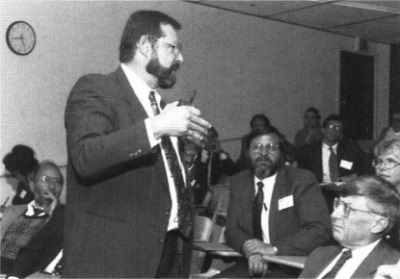Tech Transfer Meeting Draws National Labs, Industry Together

Lew Meixler of PPPL makes a point during the Technology Transfer conference held at Fermilab Oct. 6 The conference drew over 50 participants from DOE, national Iabs and industry.
Department of Energy officials, members of national dedicated program laboratories and industry leaders gathered at Fermilab October 6 to explore the benefits and the barriers of transferring technology between national labs and outside industry.
The Technology Transfer at DOE Dedicated Program Laboratories workshop grew out of the activities of the Ad Hoc Committee on Technology Transfer of Fermilab's Board of Overseers, a committee set up at the suggestion of John Peoples. The chairman of the committee is Alexander Maclachlan, retired as DuPont's Executive Vice President for Technology. Maclachlan is now in the office of the Under Secretary of Energy. From this office, it is planned that he will oversee all of DOE tech transfer. The other DOE dedicated laboratories (SLAC, CEBAF and the Princeton Plasma Physics Laboratory) were invited to join Fermilab to describe their broad technical capabilities and to work to make technology relations with industry a win-win for both their scientific programs and the nation's competitiveness.
The workshop drew over 50 participants to the day-long meeting. John Peoples opened the conference, commenting, "We are in the midst of big science. We need technology to drive it and we need tighter relationships with big industry. This is a two-way street."
Much discussion throughout the meeting centered on Cooperative Research and Development Agreements or CRADAs, one of the important mechanisms by which the labs and industry together develop and implement technology. In September, the Department of Energy passed its goal of 1,000 approved CRADAs-13 months ahead of schedule. DOE credits this success to the streamlining of the approval process and the broadening of technical support. Anne Marie Zerega of the DOE Office of Laboratory Management explained that the new streamlining cut average CRADA processing time from 32 weeks to 16 weeks.
Business leaders at the conference agreed that the process has improved, but suggested areas for continued development. "Cooperation with DOE labs is good for industry," said Charles Shanley of Motorola. "But there are problems. There is a lack of allocated funding and the inability to cut favorable deals because of exclusive rights and the worldwide use of technology (issue). What industry wants are realistic legal terms and the right to practice derived knowledge anywhere."
Steve Wallach of Convex suggested that to improve the process "both institutions have to want to collaborate and shorten the 'pipeline' to approve the agreement."
In outlining several DOE Office of Energy Research objectives, Zerega said the office intends to meet industry's needs by providing labs more flexibility in business arrangements, leveraging program funding with other Office of Energy Research programs and establishing an industry collaboration office at each lab to provide technical focus.
David Cheney, a consultant with the DOE Office of the Under Secretary, said he recognizes the needs of industry. "Industry tends to be concerned about government cycle time, (but) this is a key transition period for technology transfer and reflects the high priority technology transfer has in this administration."
Fred Dylla of CEBAF added there are many wants in technology transfer. "What we really need is a home for technology transfer and a specific funding mechanism. We need to remove funding constraints." More importantly, said Dylla, "We need to offer incentives to scientists to become involved and get interesting projects started."
To further explore the issue of technology transfer, workshop participants held afternoon breakout sessions to examine the role of the dedicated labs in major DOE partnerships, industry cultural barriers to dealing with federal labs, and structural and motivational barriers to technology transfer at dedicated laboratories.


